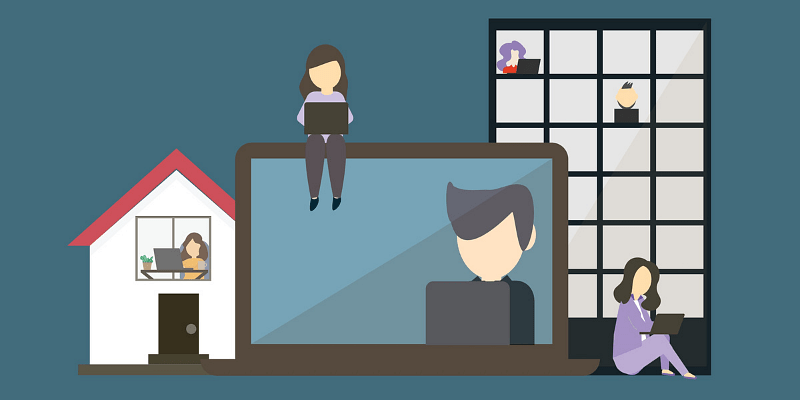In the past year, organisations across the world saw themselves shrink into a screen. Virtual existence and work from home became a way of life as workers embraced the new normal despite several glitches. But as the economy opens up, employees are hoping for a change with expectations of returning to offices.
In a recent study conducted by Steelcase across 10 countries, it was observed that 72 percent of the organisations (85 percent in India) were in favour of a hybrid model where employees can work both from home and office. Among the remaining respondents, 23 percent were expected to return to an in-office-heavy work mode, and only 5 percent were to continue an extreme work-from-home strategy (12 percent and 4 percent , respectively, in India).
Companies, on their part, are looking to make this return a seamless process to build reliance and boost productivity. According to the above report, 90 percent of employers in India expect to provide their employees greater choice and control over where they want to work from.
The return-to-office programme is likely to unfold in three phases — now, near, and far. With this format in mind, they are set to adopt flexible working styles, adhere to stringent safety protocols, and redesign workplaces.
Safety first
As the world still reels under the aftermath of the pandemic, a safe workplace is an assurance that returning to office is not akin to compromising health. While employee well-being was already a talking point even before COVID-19 struck, it has become all the more vital now. The idea is to focus on basic safety protocols, cleanliness, routine sanitisation, and adjusting space density to maintain distance.
Companies, so far, were designed to foster active interaction. An open plan with high density, more shared spaces, and intimate sitting arrangements were the norm. However, the current situation demands an overhaul.
Redesigning workstations with distance as a priority, avoiding desk-sharing, adding standalone enclosures, and having open-space meetings are some noteworthy changes. Introducing division around desks and having easily cleanable furniture material would be add-ons.
Focus on flexibility and mobility
Working from home has given workers the flexibility to exercise their choice regarding resources and time utilisation. As they are set to return to offices, this flexibility is a key expectation from employers. Providing flexibility in selecting workplace, time, sitting arrangement, etc., is fundamental toward nurturing a compelling work environment. The addition of individual spaces — for example, pods — that offer privacy would be welcome changes.
Mobility offers the shift from ‘fixed to fluid’. Mobile furniture, technologies and power solutions, and divisional screens allow quick response to disruptions, free movement, and a dynamic atmosphere. Upgraded technology with more hands-free solutions and large-scale digital collaboration devices can further enable mobility. Standing meetings are also likely to become common as open areas replace conference rooms.
The impact of the pandemic on the working style of companies has been varied. Startups, for example, were quick to adapt to newer trends, thanks to their hyper-collaborative teams.
With agility, innovation, and quick response to customer needs being their strengths, a flexible workspace is an achievable concept for them. On these lines, employees of bigger corporations are now expecting the adoption of similar restructuring.
Future of design
‘Change is the only constant’ is a mantra that needs active adoption in current times. Future workplaces would no longer be permanent, and employers have to aid this change to encourage engagement, collaboration, and productivity.
As per the Steelcase report, 82 percent of business leaders agreed on the need for flexible/modular furniture. To this end, workplace reconfiguration will concentrate on three primary aspects — density, geometry, and division. The focus should be on distance, owned spaces, partitions, and modular furniture on a broader scale.
Creating community
Working from home has brought a sense of isolation that eventually resulted in a drop in productivity. In-person meetings, severe brainstorming, and idea-sharing are the basics of the workplace ecosystem. No matter how advanced the virtual world is, it is yet to match physical communication.
Human beings need social interaction for mental and emotional stimulation, and workplaces provide a fantastic platform for building communities. Water-cooler moments, coffee breaks, and lunch-time banters can yield excellent business ideas, mentorship, and personal bonds. Hence, fostering a culture of collaboration needs focus, albeit within safety norms.
Providing work-from-home infrastructure
With the hybrid model as the future of workplaces, people would continue to work from home on some days of the week. However, the lack of a proper workspace set-up is a major drawback. Most people end up working from couches, beds, or dining tables.
Besides affecting productivity, this has led to serious health issues. Companies need to provide the required infrastructure like ergonomic chairs with maximum back support and height-adjustable desks.
The employees’ fervour for improved engagement and productivity is a golden sign for businesses. Hence, looking into their well-being and meeting their expectations are the least organisations can do to reap the benefits.
(Disclaimer: The views and opinions expressed in this article are those of the author and do not necessarily reflect the views of YS.)









